| Article ID | Journal | Published Year | Pages | File Type |
|---|---|---|---|---|
| 4907394 | The Journal of Chemical Thermodynamics | 2017 | 11 Pages |
â¢Physical properties of mixed ionic liquids having different functionality.â¢Experimental densities at pressures up to 200 MPa.â¢Mixed ionic liquids decomposed according to their pure decomposition temperatures.â¢Atmospheric and high pressure densities and viscosities show regular trends.â¢Two general methods for correlation and prediction are proposed.
In this work, high pressure density measurements were made of mixed ionic liquid systems (1-butyl-3-methylimidazolium chloride ([bmim]Cl) and 1-butyl-3-methylimidazolium bis(trifluoromethylsulfonyl)imide ([bmim][Tf2N])) for the purpose of developing efficient reaction and separation systems for processing biomass. The mixed ionic liquids were prepared at mole ratios, [bmim]Cl:[bmim][Tf2N] of 0.75: 0.25, 0.50: 0.50 and 0.25: 0.75. Density data were measured (10-200 MPa, 312-392 K) and correlated (up to 100 MPa) with the εâ-modified Sanchez-Lacombe equation of state (εâ-mod SL EoS). The density of the binary mixed ionic liquid system was modeled in two ways: (i) as a single pseudo-component or (ii) as two discrete components. By treating the mixed ionic liquids as a single pseudo-component, the εâ-mod SL EoS could correlate the high pressure density data to within a maximum average relative deviation (ARD) of 0.06%. On the other hand, by treating the mixed ionic liquids as discrete components, higher ARD values (0.15%) were obtained from the εâ-mod SL EoS that can be attributed to the EoS mixing rules. Both approaches for modeling the ionic liquid mixtures had sufficiently low deviations and will be applied to multicomponent CO2-containing systems in future works.
Graphical abstractDownload high-res image (253KB)Download full-size image
